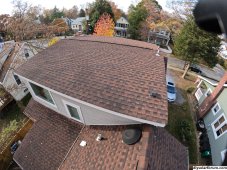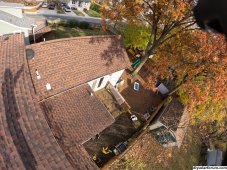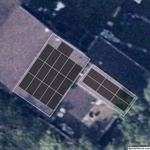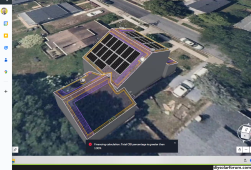You are using an out of date browser. It may not display this or other websites correctly.
You should upgrade or use an alternative browser.
You should upgrade or use an alternative browser.
Help Understanding 120% Rule
- Thread starter jmoles
- Start date
zanydroid
Solar Wizard
This is sort of an iceberg topic.
I believe the main one discussed above is using a combiner panel instead of directly feeding into the main panel. A combiner panel allows individual branch circuits to be aggregated before backfeeding into the main panel.
There are certain subtleties in code that distinguish between the AC output current and backfeed breaker size when determining the max backfeed allowed by 705.12. I believe these have been cleaned up over the years. Combiner panel has the highest probability way of maxing things out.
Not mentioned: if you strategically splice in a subpanel, you can backfeed arbitrary amount without derating the main breaker. This is probably not worth it for you unless you want to avoid an electrician completely and save money that way. It would require you to move all circuits out of the main into the strategically inserted subpanel, which is rather expensive to hire an electrician for b/c it's a lot of time, but it's also not really difficult / specialized work.
I believe the main one discussed above is using a combiner panel instead of directly feeding into the main panel. A combiner panel allows individual branch circuits to be aggregated before backfeeding into the main panel.
There are certain subtleties in code that distinguish between the AC output current and backfeed breaker size when determining the max backfeed allowed by 705.12. I believe these have been cleaned up over the years. Combiner panel has the highest probability way of maxing things out.
Not mentioned: if you strategically splice in a subpanel, you can backfeed arbitrary amount without derating the main breaker. This is probably not worth it for you unless you want to avoid an electrician completely and save money that way. It would require you to move all circuits out of the main into the strategically inserted subpanel, which is rather expensive to hire an electrician for b/c it's a lot of time, but it's also not really difficult / specialized work.
Mike 134
Solar Enthusiast
With the rates you pay compared to us in the Midwest @ $0.12-$0.14 KWH I can understand why they get all bent out of shape. When I pulled my smart meter it took the power company about 30 minutes before they called and asked if I needed a lineman to come out to check my power outage. I told them we were changing out a bad main breaker and that was the end of story.Depends on local regulations. That's not allowed here and has lead to some Kafka-esque horror stories proving that it was not done with intend to defraud (IE breaking the tamper-evident seal and creating a gap in the smart meter telemetry)
I have to say I was surprised they called.
Hedges
I See Electromagnetic Fields!
- Joined
- Mar 28, 2020
- Messages
- 20,763
A 225A busbar with 200A main breaker is a nice way to have bigger PV breaker (including more pass-through when using a hybrid inverter), but yours unfortunately is now 225A. So derating breaker is a reasonable thing to do.
You want a "10 - 12Kwh panel array" (meaning kW, not kWh). Do you want 10 - 12kW of inverter, or is 7.7kW sufficient? (32A continuous, 40A breaker, complies with 120% rule.)
10kW (STC) of PV panels is about 7.5kW to 8.5kW (PTC or NOCT). Inverter may be about 98% efficient. So a good fit, maxed out but only when sun is directly over-head. Off-season, a bigger array than 10kW needed to max it out. During the best season, a 12kW array would clip or a couple hours, maintain peak 7.7kW a bit longer.
What are your roof orientations, or planned ground mount orientations? Having multiple arrays oriented differently reduces the peak, extends the hours. If 90 degree difference between the arrays, reduces peak to 70% as much.
I think you can fit most of the production from 12kW of PV panels within 120% rule, no need to reduce breaker size.
Is there a battery in your future? That could store what would otherwise be clipped, feed it in later. With time of use tariff, backfeed when rates are higher.
Consider Sunny Boy Smart Energy (available January.)
 www.sma-america.com
www.sma-america.com
This is a 7.7kW inverter plus 10kW battery charger, supports 15kW of PV harvesting (so I'd say up to 22kW (NOCT) of PV if multiple orientations.)
Put it in overpaneled for now. Add battery later to store and time-shift production. Add backup unit later for whole-house backup.
You could do the same with other brands such as SolArk. For any hybrid, easy enough to limit backfeed within a 40A breaker, but the same 120% rule has to be addressed for passing through more current from grid to loads. I think a new 200A main breaker only service entrance panel (no branch breakers in it) would best support that.
You want a "10 - 12Kwh panel array" (meaning kW, not kWh). Do you want 10 - 12kW of inverter, or is 7.7kW sufficient? (32A continuous, 40A breaker, complies with 120% rule.)
10kW (STC) of PV panels is about 7.5kW to 8.5kW (PTC or NOCT). Inverter may be about 98% efficient. So a good fit, maxed out but only when sun is directly over-head. Off-season, a bigger array than 10kW needed to max it out. During the best season, a 12kW array would clip or a couple hours, maintain peak 7.7kW a bit longer.
What are your roof orientations, or planned ground mount orientations? Having multiple arrays oriented differently reduces the peak, extends the hours. If 90 degree difference between the arrays, reduces peak to 70% as much.
I think you can fit most of the production from 12kW of PV panels within 120% rule, no need to reduce breaker size.
Is there a battery in your future? That could store what would otherwise be clipped, feed it in later. With time of use tariff, backfeed when rates are higher.
Consider Sunny Boy Smart Energy (available January.)
Discover the Sunny Boy Smart Energy | SMA America
The hybrid inverter at the heart of the SMA Energy System, with three backup options: Sunny Boy Smart Energy ► Discover now!
This is a 7.7kW inverter plus 10kW battery charger, supports 15kW of PV harvesting (so I'd say up to 22kW (NOCT) of PV if multiple orientations.)
Put it in overpaneled for now. Add battery later to store and time-shift production. Add backup unit later for whole-house backup.
You could do the same with other brands such as SolArk. For any hybrid, easy enough to limit backfeed within a 40A breaker, but the same 120% rule has to be addressed for passing through more current from grid to loads. I think a new 200A main breaker only service entrance panel (no branch breakers in it) would best support that.
These are some great points for me to think about.I think you can fit most of the production from 12kW of PV panels within 120% rule, no need to reduce breaker size.
I'm aiming for a 12kW system because I have a big tree that adds some shading and would reduce the actual harvest. Nothing would ever run at full capacity for harvesting.
But I do need to ensure I'd pass inspection with my backfeed solution. Attached are some pics of possible layouts and the actual roofs.
Attachments
Hedges
I See Electromagnetic Fields!
- Joined
- Mar 28, 2020
- Messages
- 20,763
Sounds like a 7.7kW inverter would be a reasonable choice.
I see your picture considers setback from eaves, and walkways. Those rules have evolved, so make sure based on current rules.
Some places, the eaves count as walkway, others walkway must be inside walls.
Shadows over a panel are to be avoided when others in the string get direct sun, produce full current. Can burn up bypass diodes.
Shadows aren't so bad off-angle, and good MPPT should be able to bypass those panels. But multiple strings in parallel, heavy shading on one affects voltage others operate at. Watch out for one roof shading panels on another.
Microinverters treat each panel individually. Optimizers can help string inverters with multiple orientations, don't think they do much for shadows. String inverters have multiple MPPT inputs, and multiple inverters can be used but less cost effective.
Is that tree to the South? How is sun exposure for different times of day and seasons? It seems to be your biggest problem.
I see your picture considers setback from eaves, and walkways. Those rules have evolved, so make sure based on current rules.
Some places, the eaves count as walkway, others walkway must be inside walls.
Shadows over a panel are to be avoided when others in the string get direct sun, produce full current. Can burn up bypass diodes.
Shadows aren't so bad off-angle, and good MPPT should be able to bypass those panels. But multiple strings in parallel, heavy shading on one affects voltage others operate at. Watch out for one roof shading panels on another.
Microinverters treat each panel individually. Optimizers can help string inverters with multiple orientations, don't think they do much for shadows. String inverters have multiple MPPT inputs, and multiple inverters can be used but less cost effective.
Is that tree to the South? How is sun exposure for different times of day and seasons? It seems to be your biggest problem.
zanydroid
Solar Wizard
I think these smart meters are able to remotely shut off the power, so requesting same day turn off/on is not that much overhead for the POCO.With the rates you pay compared to us in the Midwest @ $0.12-$0.14 KWH I can understand why they get all bent out of shape. When I pulled my smart meter it took the power company about 30 minutes before they called and asked if I needed a lineman to come out to check my power outage. I told them we were changing out a bad main breaker and that was the end of story.
I have to say I was surprised they called.
Have you contacted your AHJ and POCO to see what they allow? Or if you can't get visibility from someone within the same POCO I recommend posting on r/solar to see if there are any nibbles.But I do need to ensure I'd pass inspection with my backfeed solution. Attached are some pics of possible layouts and the actual roofs.
In addition to line vs load side tap you also need to know the general interconnect rules.
If there are any trees/shading, half-cut cells will go a long way (theoretically) towards preventing bypass diodes from being picked.Shadows over a panel are to be avoided when others in the string get direct sun, produce full current. Can burn up bypass diodes.
In spot checking my microinverters on half-cut cells I rarely see bypass diodes activated. On HM-1500-2T (four input two tracker) the probability ought to be even lower because each tracker has 2P going into it, so activating a bypass diode will cut a ton of power in many cases. For the HMS generation I believe most of the North America inventory is the 4-tracker version, so this does not apply (also it likely adds some cost, but the inventory is what it is).
Most microinverters also will never activate 2 bypass diodes since that drops the module well below operating voltage. I believe this also applies for optimizers.
Optimizers can work for shading as well as different orientation. Depends on whether they have MPPT / global voltage management. Tigos have neither and are designed to only ever reduce voltage. Still waiting for more details about the new SolArk optimizers (they have MPPT, not sure if they can both decrease and increase voltage). I don't think you want to be using bleeding edge MLPEs though.
Hedges
I See Electromagnetic Fields!
- Joined
- Mar 28, 2020
- Messages
- 20,763
If there are any trees/shading, half-cut cells will go a long way (theoretically) towards preventing bypass diodes from being picked.
Half-cut cell panels are just an array of 2p3s panels with 3 bypass diodes.
Shading on one cell cuts current in half but sustains voltage. If voltage is pulled lower by MPPT, then it can deliver full current, 2/3 voltage.
Not all MPPT are smart enough; some would reduce power of entire string by 1/2, rather than by 1/3 of one panel (about 1/30th of string's power.)
OP's situation will depend on how much shading.
I of course am a fan of string inverters. Microinverters may work better in his case, but have to plan for what battery backup system is desired.
zanydroid
Solar Wizard
Sure. The parallel connections reduce the number of scenarios where an optimal tracker will activate a bypass diode.Half-cut cell panels are just an array of 2p3s panels with 3 bypass diodes.
It's possible that a global MPPT will have trouble with the more complex curve, I suspect there isn't standardized testing data of sufficient quality to decide this either way. A bad global MPPT could just as easily pick the wrong voltage for a full cut string, right?
Hedges
I See Electromagnetic Fields!
- Joined
- Mar 28, 2020
- Messages
- 20,763
A single full-cell string should have one local and global maxima.
Partial light (or off angle) could result in a local maxima of higher voltage, lower current. I could imagine branches of a fir tree or deciduous tree doing that. But heavy shade on a single cell should drop current to near zero, so any MPPT that just dithers voltage would move lower.
Periodic full sweeps would leave local maxima and find global maxima.
Partial light (or off angle) could result in a local maxima of higher voltage, lower current. I could imagine branches of a fir tree or deciduous tree doing that. But heavy shade on a single cell should drop current to near zero, so any MPPT that just dithers voltage would move lower.
Periodic full sweeps would leave local maxima and find global maxima.
My county follows 2018 NFPA1, so I need to check on how that impacts my roof space for the panel layout. My AHJ is not very responsive but I'll give them a try.Sounds like a 7.7kW inverter would be a reasonable choice.
I see your picture considers setback from eaves, and walkways. Those rules have evolved, so make sure based on current rules.
Some places, the eaves count as walkway, others walkway must be inside walls.
Shadows over a panel are to be avoided when others in the string get direct sun.
Is that tree to the South? How is sun exposure for different times of day and seasons? It seems to be your biggest problem.
I had quotes from a Solar Company where I saw how the sunlight hit my roof over the year but other than PVWatts don't have access to something for better modeling.
I don't plan to do any battery system.
zanydroid
Solar Wizard
Have you looked at the trend of power prices in your area?I don't plan to do any battery system.
At some point very soon here in California, battery price decrease and utility price increase will crossover such that the breakeven of a DIY installed UL9540 ESS is like 5-7 years, so the smart thing to do for us is to have a plan in place.
Hedges
I See Electromagnetic Fields!
- Joined
- Mar 28, 2020
- Messages
- 20,763
If no battery, microinverters may deal best with shade.
But you're planning on net metering, and if there's anything you can count on, it is that regulators will pull the rug out from under you.
Here in California, under NEM 3.0, having a battery to shift import/export times is the only way to make PV worthwhile. Otherwise, better off without, just buying from utility.
So I suggest something like batteries-optional Sunny Boy Smart Energy for at least part of the system. Maybe microinverters for areas that get shade, or just strings of panels into one of 3 MPPT inputs of SBSE and let shadows fall where they may.
I think with current pricing, the HV batteries from BYD would cost $0.10/kWh of cycle life, some 16 years of daily cycling. Have to double-check that math, and compare to your rates. Makes sense in some high-cost parts of the country but not others.
Are you required to have RSD? That would mean smaller additional cost for optimizers or for microinverters.
But you're planning on net metering, and if there's anything you can count on, it is that regulators will pull the rug out from under you.
Here in California, under NEM 3.0, having a battery to shift import/export times is the only way to make PV worthwhile. Otherwise, better off without, just buying from utility.
So I suggest something like batteries-optional Sunny Boy Smart Energy for at least part of the system. Maybe microinverters for areas that get shade, or just strings of panels into one of 3 MPPT inputs of SBSE and let shadows fall where they may.
I think with current pricing, the HV batteries from BYD would cost $0.10/kWh of cycle life, some 16 years of daily cycling. Have to double-check that math, and compare to your rates. Makes sense in some high-cost parts of the country but not others.
Are you required to have RSD? That would mean smaller additional cost for optimizers or for microinverters.
Last edited:
In Maryland (where I am) the POCO's are required to pay the same rate they charge for the net metering. I haven't heard of POCO's ripping people of with net metering but sounds like I should do a little more homework.If no battery, microinverters may deal best with shade.
But you're planning on net metering, and if there's anything you can count on, it is that regulators will pull the rug out from under you.
Are you required to have RSD? That would mean smaller additional cost for optimizers or for microinverters.
For the RSD, you just mean the microinverters qualify as the RSD so I wouldn't need to price in the cost of putting one in?
Hedges
I See Electromagnetic Fields!
- Joined
- Mar 28, 2020
- Messages
- 20,763
Yup. With single panel < 80Voc feeding each microinverter, there is no HV DC. Just shut off AC and it is safe for firemen.
(presumably the laws were created for the benefit of Enphase, not for firemen.)
You can expect some changes to net metering in the future. It is not sustainable for 100% of customers to generate 100% of their energy and utility to not get revenue for wires. Or for buying power at night that PV customers use. About the best we can hope for is 20 year grandfathering.
SMA has been competitive in inverter pricing and highly reliable. The new models will cost more at least initially. Previous SB was maybe $2500 msrp for 7.7kW, but $1800 street price. So near-term project could cost more. New model has more flexible 15A per MPPT vs. 10A.
Are you required to use grid-support inverters? If your requirements trail behind ours, there may be bargain new-old-stock or used inverters. Once you've wired independent PV strings, easy to swap inverters in the future. If RSD, requires compatibility of keep-alive signal. Tigo may not be exactly SunSpec. SMA has some they rebrand.
(presumably the laws were created for the benefit of Enphase, not for firemen.)
You can expect some changes to net metering in the future. It is not sustainable for 100% of customers to generate 100% of their energy and utility to not get revenue for wires. Or for buying power at night that PV customers use. About the best we can hope for is 20 year grandfathering.
SMA has been competitive in inverter pricing and highly reliable. The new models will cost more at least initially. Previous SB was maybe $2500 msrp for 7.7kW, but $1800 street price. So near-term project could cost more. New model has more flexible 15A per MPPT vs. 10A.
Are you required to use grid-support inverters? If your requirements trail behind ours, there may be bargain new-old-stock or used inverters. Once you've wired independent PV strings, easy to swap inverters in the future. If RSD, requires compatibility of keep-alive signal. Tigo may not be exactly SunSpec. SMA has some they rebrand.
zanydroid
Solar Wizard
Rip off means the rules change. Whether wholescale or by changing the rate plan.I haven't heard of POCO's ripping people of with net metering but sounds like I should do a little more homework.
Both has happened in California.
For instance I get compensated by retail. But imagine a situation where retail cost when solar is producing is 0.05/KWh but at night it is 0.50/KWh. Fake numbers to make it obvious
We actually have $0.30 vs $0.60 peak solar output vs peak demand price
zanydroid
Solar Wizard
It is not, and there are two Tigo communications methods. One that is like sunspec but not compatible (in my headcanon it’s due to their lawsuit with sunspec)Tigo may not be exactly SunSpec.
One that is wireless
zanydroid
Solar Wizard
I would be surprised if there’s that many AHJ where module level RSD for rooftop is optional. I believe that came in with NEC2017. Long time ago
Indiana is still on NEC 2008, still a few places on NEC 2014 as well. (Not necessarily relevant to this thread)I would be surprised if there’s that many AHJ where module level RSD for rooftop is optional. I believe that came in with NEC2017. Long time ago
Similar threads
- Replies
- 4
- Views
- 237
- Replies
- 4
- Views
- 425







